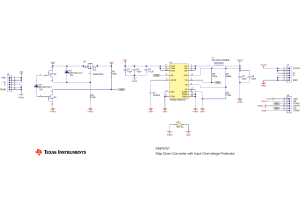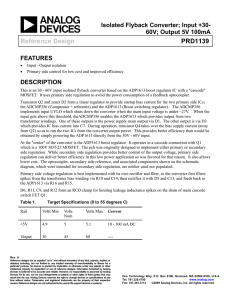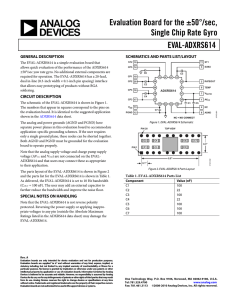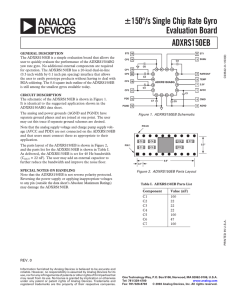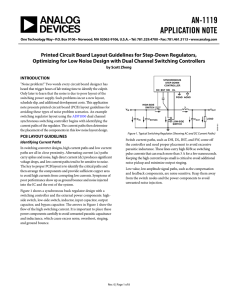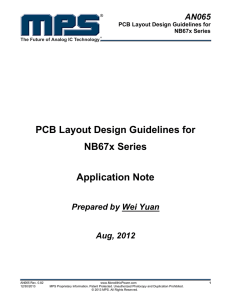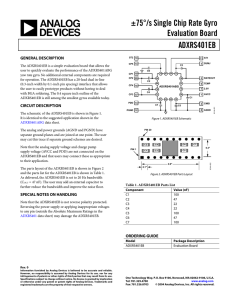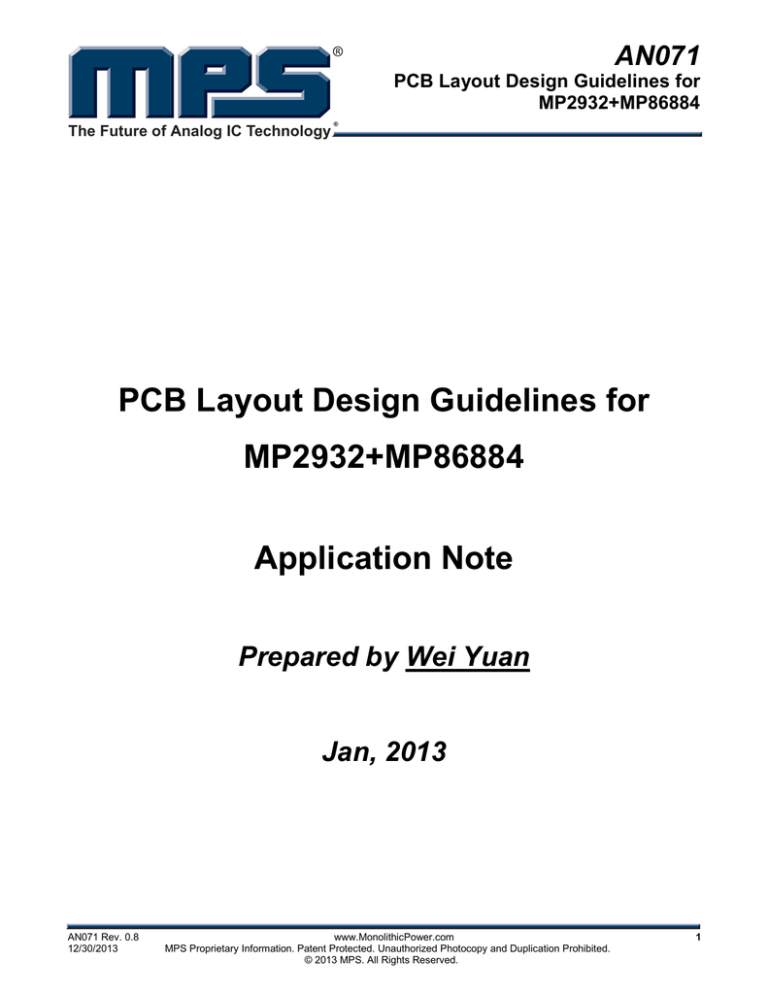
AN071
PCB Layout Design Guidelines for
MP2932+MP86884
The Future of Analog IC Technology
PCB Layout Design Guidelines for
MP2932+MP86884
Application Note
Prepared by Wei Yuan
Jan, 2013
AN071 Rev. 0.8
12/30/2013
www.MonolithicPower.com
MPS Proprietary Information. Patent Protected. Unauthorized Photocopy and Duplication Prohibited.
© 2013 MPS. All Rights Reserved.
1
AN071 – PCB LAYOUT DESIGN GUIDELINES FOR MP2932+MP86884
ABSTRACT
This application note gives the detail layout guidelines for MPS high current VR solution-MP2932+MP86884, combined with AN057, this AN focus on how to make a proper PCB layout and
then reach an optimal and stable operation.
Layout for High Current Intergrated intelli-phase
Other than the traditional VR power solution that makes driver and MOSFETs separately, MPS
provides a high power density integrated solutions for the driver and MOSFETs, with output current
around 40A in a small QFN6*6 package, named as Intelli-phase, this kind of integrated structure makes
the converter much smaller and can also reduce the leakage parameters, contribute to higher switching
frequency and also higher efficiency by optimal dead time control. However, the advantage of the fully
integration of the driver logic and power FETs makes these parts noise sensitive once the PCB layout
is not well designed, what worse is, the leakage inductance from a poor PCB layout may cause strong
ringing and then deteriorate the reliability and efficiency, hence, a carefully designed PCB Layout is
required to ensure a proper operation.
AN071 Rev. 0.8
12/30/2013
www.MonolithicPower.com
MPS Proprietary Information. Patent Protected. Unauthorized Photocopy and Duplication Prohibited.
© 2013 MPS. All Rights Reserved.
2
AN071 – PCB LAYOUT DESIGN GUIDELINES FOR MP2932+MP86884
INDEX
Abstract ................................................................................................................................................. 2 Layout for High Current Intergrated intelli-phase............................................................................. 2 Introduction............................................................................................................................................ 4 How Important a Layout is to the High Current DC-DC Converters................................................. 4 General Design Guidelines ............................................................................................................. 4 Critical Design Notes for The PCB Layout ............................................................................................. 5 Input Capacitor ............................................................................................................................... 5 1) Input Cap without Forbidden area............................................................................................ 5 2) Input Cap with Forbidden area................................................................................................. 6 VDD/VDDDRV Decoupling Capacitors ........................................................................................... 7 Enhance Input Power Trace ........................................................................................................... 8 BST RC Place and Trace.............................................................................................................. 10 GND Connections......................................................................................................................... 10 General Recommend PCB Layout for MP86884.................................................................................. 12 Recommend Layout For MP86884 without Forbidden Area.......................................................... 12 Recommend Layout For MP86884 with Forbidden Area............................................................... 13 MP2932 PCB guidelines ...................................................................................................................... 14 Remote Sense on MP2932........................................................................................................... 14 Feedback Loop of MP2932........................................................................................................... 14 Current Sense from MP86884 to mp2932............................................................................................ 16 VR Placement...................................................................................................................................... 17 AN071 Rev. 0.8
12/30/2013
www.MonolithicPower.com
MPS Proprietary Information. Patent Protected. Unauthorized Photocopy and Duplication Prohibited.
© 2013 MPS. All Rights Reserved.
3
AN071 – PCB LAYOUT DESIGN GUIDELINES FOR MP2932+MP86884
INTRODUCTION
How Important a Layout is to the High Current DC-DC Converters
The MP2932+MP86884 is a compact high efficiency power solution for high current power supply, etc.,
CPU, it can support up to 240A output current by one controller(MP2932) and interleaved intelliphase(MP86884). For these highly integrated devices with high current and high switching frequency, a
poor layout will degrade the performance of the converter, cause ground bounce, EMI problems,
resistive power loss, high voltage stress on power FETs, poor line and load regulation and even system
instability. Hence, a good layout is one of the key factors in the switching mode power supply system
General Design Guidelines
There are some general design guidelines for a proper layout. Generally, the MP86884 is the power
device so that it requires more careful design layout, and what need to be done for MP86884 is noise
immunity and remote sense.
1.
For MP86884:
1) The power trace (IN, PGND, SW) should be placed short and wide with minimized loop area. That
means, the input capacitor should be placed as close as possible to the IC, etc., placed next to IN
and PGND, the inductor should be placed close to the SW PIN and connect directly to the output
capacitor.
2) The VDD decoupling capacitors should be placed close to VDD and VSS PIN, for each phase of
MP86884, connect its VSS to inner PGND layout by vias. The VDDDRV decoupling cap should also
be connected next to the VDDDRV and PGND.
3) For a better thermal performance, at least two layers are required to form IN and PGND trace, add
several Vias with10mil_drill/20mil_copper width in the bottom and also close to the IN and PGND
pads to help on thermal dissipation. And 8 layers are the Min requirement for the PCB board
4) The sensitive traces like VDD and CS (current sense),remote sense (VSEN,RGND), should be
placed far from high dv/dt signals,( e.g SW,PWM,BST).
5) Keep the BST voltage path (path from BST to SW) as short as possible with at least 25mil trace.
and put the BST cap as close to the device as possible.
2.
For MP2932:
1)
The VCC decoupling capacitor should be placed close to VCC and connected to inner PGND layer
by vias.
2)
The remote sense point should be connected to the sense point near CPU separately with small
loop traces, do not mix the VSEN and RGND with any other signal. 3) The noise sensitive
AN071 Rev. 0.8
12/30/2013
www.MonolithicPower.com
MPS Proprietary Information. Patent Protected. Unauthorized Photocopy and Duplication Prohibited.
© 2013 MPS. All Rights Reserved.
4
AN071 – PCB LAYOUT DESIGN GUIDELINES FOR MP2932+MP86884
trace (FB, CS, VCC) should be placed far away from SW, PWM or BST trace. 4) Suggest no via on FB
pin, that means put the compensation loop parameters in the same layer with the controller.
CRITICAL DESIGN NOTES FOR THE PCB LAYOUT
The above section describes some general layout recommendations that should be considered, this
section will focus on some specific layout suggestions that are quite important for this system. One
should strictly follow these design notes for a better and strong performance.
Input Capacitor
1) Input Cap without Forbidden area
For the main power loop, the input capacitors should be placed as close to the IN and PGND pins as
possible, these connections should be done with short, direct and wide traces. The decoupling cap,
usually the smallest ceramic cap, should be placed most close to the IN and PGND pins of the
MP86884, so as to make the best decoupling effect.
Figure 1 describes the optimized input cap placement based on MP86884
Figure 1—Optimized and recommend input capacitor placement
The input cap should be carefully placed to reduce the leakage inductance, or else, the high voltage
spike caused by the di/dt would cause extra voltage stress to the HS MOS. Layout shown in Figure 2
are some common unqualified VIN capacitor layouts which will degrade the performance and stability.
For Figure 2-a), the input cap is put far away from Vin and PGND pins, this will increase the leakage
from Vin Cap to HS MOS, leading to higher voltage stress during switching periods. This layout is quite
common because of the forbidden area.
AN071 Rev. 0.8
12/30/2013
www.MonolithicPower.com
MPS Proprietary Information. Patent Protected. Unauthorized Photocopy and Duplication Prohibited.
© 2013 MPS. All Rights Reserved.
5
AN071 – PCB LAYOUT DESIGN GUIDELINES FOR MP2932+MP86884
For Figure 2-b), the input cap is placed quite close to the IN pin, however, the cap that placed closest to
SW 1
T2 VTEMP EN
27
26
Too long
24
T1
25
CS
28
30
DT
IN
23
IN
IN
22
IN
PGND
21 PGND
PGND
20
PGND
PGND
19
PGND
PGND
18
PGND
IN
SW
SW 2
SW
SW 3
SW
SW 4
SW
9
10
11
12
13
14
15
16
17
PGND
PGND
PGND
PGND
PGND
PGND
PGND
8
PGND
PGND
PGND
SW
PGND
SW
SW 6
VDDDRV
SW 5
7
a), NG, Cap placed far from Vin and GND
31
32
33
34
BST SYNC PWM VDD VSS
29
IN and PGND should be the ceramic decoupling Cap, not the Bulk Cap.
b) NG, Decoupling Cap placed far away from Vin and
PGND
Figure 2— Unqualified input capacitor placement
2) Input Cap with Forbidden area
In some of the applications, there is a forbidden area around the IC, and it is not allowed to put the
decoupling cap close to the IC inside the forbidden area. In this case, it is strongly recommended to
place a ceramic cap in the bottom of the part, Figure 3 shows the recommend input capacitor layout for
applications with forbidden area
Figure 3—Recommend input capacitor placement for applications with forbidden area
AN071 Rev. 0.8
12/30/2013
www.MonolithicPower.com
MPS Proprietary Information. Patent Protected. Unauthorized Photocopy and Duplication Prohibited.
© 2013 MPS. All Rights Reserved.
6
AN071 – PCB LAYOUT DESIGN GUIDELINES FOR MP2932+MP86884
VDD/VDDDRV Decoupling Capacitors
The VDD/VDDDRV are 5V inputs that powers internal logic/driver of MP86884, the decoupling
capacitors plays an important role in the DC-DC converters to make the logic circuits not noised
coupled and also limit the driver leakage inductance.
The VDD/VDDDRV cap is required to be placed as close to the VDD/VDDDRV pin as possible. It is
highly recommended to put these caps in the same layers with the MP86884 so that less or no via is
required since via will induce additional leakage inductance.
Figure 4-a) describes the recommend VDDDRV cap placement. While Figure 4-b) has a VDD cap
placed far away from VDDDRV and AGND pins, which is not good.
a) Recommend VDDDRV Cap placement
b) Not Good VDDDRV Cap place
Figure 4—VDDDRV capacitor placement for MP86884
For the VDD decoupling Cap, it should be connected to VSS first before the VSS is connected to
PGND. Figure 5-a) describes the recommend VDD cap placement; the cap is connected to VDD and
VSS directly in the same layer of the MP86884. And VSS is then connected to inner PGND layer by
vias near the cap. Figure 5-b) shows an improper cap to VSS connection, this improper layout will
increase the leakage from cap to the VSS Pin, and the system might get noise affected sense the
PGND is quite noisy.
AN071 Rev. 0.8
12/30/2013
www.MonolithicPower.com
MPS Proprietary Information. Patent Protected. Unauthorized Photocopy and Duplication Prohibited.
© 2013 MPS. All Rights Reserved.
7
AN071 – PCB LAYOUT DESIGN GUIDELINES FOR MP2932+MP86884
Leakage Inductance
induced by vias
BST SYNC PWM VDD VSS
SW 1
CS
T1
T2 VTEMP EN
BST SYNC PWM VDD VSS
IN
23
IN
IN
22
IN
SW 1
SW
SW 2
SW
SW 3
SW
SW 4
DT
PGND
21
PGND
PGND
20
PGND
PGND
19
PGND
PGND
18
PGND
SW
SW 5
SW
SW 6
SW
Top layer
Inner PGND Layer
Via
MP86884
a) Recommend VDD Cap placement
CS
T1
T2 VTEMP EN
IN
23
IN
IN
22
IN
PGND
21
PGND
PGND
20
PGND
PGND
19
PGND
PGND
18
PGND
SW
SW 2
SW
SW 3
SW
SW 4
DT
SW
SW 5
SW
SW 6
SW
MP86884
b) Not Good VDD Cap placement
Figure 5—Recommend VDD capacitor placement for MP86884
Enhance Input Power Trace
The MP86884 series provides high power density solutions for DC-DC converters with output current
up to 40A in a small QFN6*6 package, hence, a better thermal design is expected to prevent the
converter from a high temp rise. It is recommended that:
1) At least two layers is need for the IN and PGND power trace, keep it short, direct and wide, and
connect the two layers with vias. These vias are recommended to have 10mil_drill/20mil_copper
width.
2) The Vias placed under the part is quite important for the thermal dissipation, it also helps to reduce
the leakage inductance to the power MOS. It is strongly recommended to place vias on the IN and
PGND pins under the part.
3) Also, for a better thermal dissipation, place as many vias as possible (>20) between the two input
trace layers next to the VIN and PGND pins around the input capacitors.
4) Do not place too much vias that will block the current flow, etc., room between outside input cap
and MP86884’s IN and PGND pins. See Figure 6 for details
Figure 5 and 6 describe the recommend layout for the enhanced IN and PGND trace. For Figure 5 the
enhanced input layer is Top (IN and PGND, SW), inner1 (PGND) and inner2 (IN and PGND)
AN071 Rev. 0.8
12/30/2013
www.MonolithicPower.com
MPS Proprietary Information. Patent Protected. Unauthorized Photocopy and Duplication Prohibited.
© 2013 MPS. All Rights Reserved.
8
AN071 – PCB LAYOUT DESIGN GUIDELINES FOR MP2932+MP86884
Figure 5—Recommend enhanced VIN and PGND Trace for MP86884
Figure 6 is the recommend layout when there is a bottom decoupling cap due to the forbidden area, the
enhanced input layer is top (IN and PGND,SW), inner1 (PGND) and inner 7 (assume total 8 layers),
bottom(IN and PGND)—refer to Figure 6.
Figure 6—Recommend enhanced VIN and PGND Trace for MP86884 with Forbidden area
AN071 Rev. 0.8
12/30/2013
www.MonolithicPower.com
MPS Proprietary Information. Patent Protected. Unauthorized Photocopy and Duplication Prohibited.
© 2013 MPS. All Rights Reserved.
9
AN071 – PCB LAYOUT DESIGN GUIDELINES FOR MP2932+MP86884
BST RC Place and Trace
The BST Cap provides a power source for the HS MOS driver, the BST node changes when SW
switches, so it is recommended to shrink the loop from the BST to SW and also make the leakage
inductance smaller by >25mil traces. Figure 8-a) shows the recommend BST RC traces, and Figure 7-b)
presents an example of a not good BST trace.
31
30
29
28
27
26
25
24
PGND
PGND
PGND
PGND
PGND
PGND
PGND
PGND
32
PGND
18
PGND
19
33
PGND
PGND
PGND
PGND
34
20
PGND
PGND
17
PGND
16
21
15
PGND
14
IN
13
22
12
IN
IN
11
23
9
IN
10
a)
T2 VTEMP EN
SW
SW 2
SW
SW 3
SW
SW 4
SW
SW 5
SW
SW 6
T1
8
sw
CS
7
SW 1
DT
VDDDRV
BST SYNC PWM VDD VSS
SW
Recommend VDD cap and resistor placement, small
b)
Not Good BST trace
loop and with 25mil traces
Figure 7—Recommend feedback resistors placement
GND Connections
For the MP2932+MP86884 solutions, there are several GNDs that should be designed carefully.
1) For the MP2932, it is a controller with no high power loop, so all the pull low(except the RGND)
should be connected to a AGND pad before it is connected to PGND layer, so it is suggested to set
a inner AGND island for MP2932, all the AGND(signal GND) near the chip would connected to this
island first by vias, do remember that these vias are not connected to inner PGND layer, the inner
AGND island should be connected to PGND with kelvin connections finally.
2) For the MP86884, the Input cap and VDDDRV Cap should be connected to PGND in the same
layer with the IC, and the VSS should be first connected to the VDD Cap before it is connected to
PGND layer by vias.
3) For the MP86884, each phase should have a separated GND traces before they are connected to
inner PGND layer, that means, do not connected the PGND of one phase to VSS of another phase
in the top or bottom layer.
AN071 Rev. 0.8
12/30/2013
www.MonolithicPower.com
MPS Proprietary Information. Patent Protected. Unauthorized Photocopy and Duplication Prohibited.
© 2013 MPS. All Rights Reserved.
10
AN071 – PCB LAYOUT DESIGN GUIDELINES FOR MP2932+MP86884
EN
24
T2 VTEMP
25
T1
26
CS
27
DT
28
30
31
32
33
34
BST SYNC PWM VDD VSS
29
Top layer
Inner PGND Layer
Via
MP86884
SW 1
PGND
PGND
BST SYNC PWM VDD VSS
DT
CS
T1
T2 VTEMP EN
MP86884
SW 1
Separated
IN
23
IN
22
IN
PGND
21
PGND
PGND
20
PGND
PGND
19
PGND
PGND
18
PGND
IN
SW
SW 2
SW
SW
SW 6
SW
9
11
12
13
14
15
16
17
8
10
PGND
SW
SW 5
PGND
SW
SW 4
VDDDRV
SW 3
7
RGND:To Remote
CPU GNDs
PGND
24
Kelvin
connections
PGND
2
4
PGND
2
3
PGND
VCC
2
2
PGND
2
1
PGND
2
0
PGND
1
9
PGND
1
8
PGND
1
7
PWM5
1
6
ISEN5-
1
5
ISEN5+
PWM2
1
4
SD
25
1
3
VSEN
12
RGND
DAC
VDIFF
ISEN2+
IDROOP
ISEN2-
26
FB
27
11
REF
10
COMP
OFS
IOUT
PGND
VSS Connected to Inner PGND
layer though Vias, not to the
PGND of another phase
25
ISEN4-
PGND
28
26
9
PGND
ISEN4+
VRSEL
27
PWM4
ID0
29
PGND
PWM1
30
8
PGND
31
7
28
6
ID1
29
ID2
PGND
PGND
ISEN1+
30
32
18
PGND
5
PGND
PGND
ID3
SW
31
ISEN1-
SW 6
32
33
PGND
17
ISEN3-
4
19
16
ISEN3+
34
PGND
PGND
15
35
MP2932
SW
14
PWM3
SW 5
13
36
20
PGND
3
7
PGND
VDDDRV
3
8
33
3
9
SW
34
4
0
PWM6
ISEN6-
4
1
ISEN6+
EN_PWR
FS
EN_VTT
OVP
SS
VR_RDY
TM
VR_FAN
4
2
SW
SW 4
12
ID4
4
3
SW 3
11
3
4
4
21
10
2
ID5
4
5
IN
PGND
SW
9
ID6
4
6
IN
22
8
1
4
7
23
7
ID7
VR_HOT
SW 2
4
8
IN
IN
SW
VDDDRV Cap to PGND
directly
Figure 8—Recommend System GND connections
AN071 Rev. 0.8
12/30/2013
www.MonolithicPower.com
MPS Proprietary Information. Patent Protected. Unauthorized Photocopy and Duplication Prohibited.
© 2013 MPS. All Rights Reserved.
11
AN071 – PCB LAYOUT DESIGN GUIDELINES FOR MP2932+MP86884
GENERAL RECOMMEND PCB LAYOUT FOR MP86884
Based on above sections, the map of PCB layout with all the design noted included is shown below.
We recommend use at least 8 layer PCB for the MP2932+MP86884 high current solution. The layer
structure could be as follow.
Recommend Layout For MP86884 without Forbidden Area
At least 8 layers board is required for our high current Intelli-phase. Make sure that there is PGND layer
next to the main power layer so as to make a small power loop.
1) For the structure like Figure 9, the Min required main power loop will be in top 3 layers
2) Do not put the noise sense signal (such as CS, Vsen, FB,VDIFF) close to noise node (SW,BST or
PWM), even they are placed in different layers, remember to separated them with proper distance.
Top layer
VDD Cap To Inner PGND Layer
Inner Power Layer
SW 1
27
26
24
T2 VTEMP EN
25
T1
28
30
CS
VIN
IN
23
IN
IN
22
IN
PGND
21 PGND
PGND
20
PGND
PGND
19
PGND
PGND
18
PGND
SW
SW 2
SW
SW 3
SW
SW 4
SW
9
11
12
13
14
15
16
17
PGND
PGND
PGND
PGND
PGND
PGND
8
10
7
PGND
SW
PGND
SW
SW 6
VDDDRV
SW 5
PGND
sw
DT
PGND
L
31
32
33
34
BST SYNC PWM VDD VSS
29
Via
PGND
Thermal
Vias
VDDDRV
Cap
Top Layer: Components and main power trace,
Mid-Layer1:PGND
Mid-Layer2:Main power trace
Mid-Layer3:PGND,Signal(etc,PWM)
Mid-Layer4:Signal,VCC,PGND
Mid-Layer5:Signal(etc,Current Sense,Vosense)
Mid-Layer6:PGND
Bottom Layer: Components and other traces
Figure 9—Recommend PCB Layout for MP86884
AN071 Rev. 0.8
12/30/2013
www.MonolithicPower.com
MPS Proprietary Information. Patent Protected. Unauthorized Photocopy and Duplication Prohibited.
© 2013 MPS. All Rights Reserved.
12
AN071 – PCB LAYOUT DESIGN GUIDELINES FOR MP2932+MP86884
Recommend Layout For MP86884 with Forbidden Area
At least 8 layers board is required for our high current Intelli-phase. Make sure that there is PGND layer
next to the main power layer so as to make a small power loop.
1) For the structure like Figure 10—with forbidden area, the Min required main power loop will be in
top and bottom layers, also, with PGND layers next to the top and bottom layers, to reach a small
loop.
Do not put the noise sensitive signal (such as CS, Vsen, FB,VDIFF) close to noise node(SW,BST or
31
30
29
28
27
26
25
24
PGND
PGND
PGND
PGND
PGND
PGND
PGND
32
17
PGND
16
33
15
PGND
14
34
13
PGND
12
9
11
8
10
7
VDDDRV
PWM), even they are placed in different layers, remember to separated them with proper distance.
Figure 10—Recommend PCB Layout for MP86884 with Forbidden area
AN071 Rev. 0.8
12/30/2013
www.MonolithicPower.com
MPS Proprietary Information. Patent Protected. Unauthorized Photocopy and Duplication Prohibited.
© 2013 MPS. All Rights Reserved.
13
AN071 – PCB LAYOUT DESIGN GUIDELINES FOR MP2932+MP86884
MP2932 PCB GUIDELINES
Other than the GND connection that is described in the above section, there are some other notes for
MP2932 layout.
Remote Sense on MP2932
The VSEN and RGND pin on MP2932 provides a way to accurate sense the output voltage from the
remote load (CPU), hence:
1) The sense point should be placed near the CPU with separated wire. Do not connect the RGND
directly to PGND layer, or connect the VSEN to Vout that is far from the CPU.
2) Suggest put two 5-20ohms impedance match resistors in the remote sense wire, and a 10-100pF
Cap (optional) for high frequency noise filter.
Figure 11 shows the details of the recommend remote sense of MP2932.
Figure 11—Recommend remote sense of MP2932.
Feedback Loop of MP2932
The feedback loop plays an important role for the system stability, usually there are two kinds of
compensation loop, type III and type II compensation as shown in Figure 12.
1) Type III compensation is commonly used for traditional no droop voltage mode control, where the
output voltage keeps the same when load increase, as was shown in Figure 12-a), and It should be
AN071 Rev. 0.8
12/30/2013
www.MonolithicPower.com
MPS Proprietary Information. Patent Protected. Unauthorized Photocopy and Duplication Prohibited.
© 2013 MPS. All Rights Reserved.
14
AN071 – PCB LAYOUT DESIGN GUIDELINES FOR MP2932+MP86884
noted that usually, type III compensation is suggested on the PCB Layout for it is also compatible for
type II compensation where the droop function is applied, as shown in Figure 12 –b).
2) Place a resistor footprint (Can be NS or 0ohm) between FB and IDroop pin if it is not decide to use
droop or not. This is to increase the design flexibility.
No droop a) Type III compensation-suggested for no droop
applications and PCB layout since the R1 and C1
can be NS
With droop b)
Type II compensation, only applied when there is
droop function.
Figure 12—Recommend compensation of MP2932.
3) FB pin is noise sensitive, to avoid the leakage inductance, via is not allowed between FB pin and
resistors/capacitors that are connected to it. So it is recommended that the feedback loop should be
placed in the same layer with MP2932, as shown in Figure13.
FIGURE 13—RECOMMEND COMPENSATION LOOP PLACEMENT.
AN071 Rev. 0.8
12/30/2013
www.MonolithicPower.com
MPS Proprietary Information. Patent Protected. Unauthorized Photocopy and Duplication Prohibited.
© 2013 MPS. All Rights Reserved.
15
AN071 – PCB LAYOUT DESIGN GUIDELINES FOR MP2932+MP86884
CURRENT SENSE FROM MP86884 TO MP2932
The communication signal between MP86884 to MP2932 includes CS and PWM, the PWM is noisy
while the CS signal is noise sensitive for its current since accuracy, these two signals need to take
good care for a better layout, generally, the layout should follow:
1, The distance from CS to PWM trace should be kept longer than 3 times of PWM width, usually>30mil,
even if they are set in different layers, see figure. 14
2, The CS trace should also be kept away from SW pad, which is much more noisy than PWM.
3, The Vout point of the CS loop should be kept together before it is tied to output Cap.
Figure 14—Recommend CS and PWM signal placement.
Figure 15—Recommend Vout connection for CS Loop.
AN071 Rev. 0.8
12/30/2013
www.MonolithicPower.com
MPS Proprietary Information. Patent Protected. Unauthorized Photocopy and Duplication Prohibited.
© 2013 MPS. All Rights Reserved.
16
AN071 – PCB LAYOUT DESIGN GUIDELINES FOR MP2932+MP86884
VR PLACEMENT
The VR module handles large current and the efficiency and thermal is quite important for the system
reliability, the distance between VR and CPU will affect the copper impedance and also the leakage
from VR to CPU, the copper impedance will cause higher conduction loss and then temperature rise,
and the leakage inductance will affect the loop Bandwidth, so improve the efficiency and also simplify
the loop design, it is suggest to put the VR as close to CPU as possible, and set the initial BW to 1/10
Fs. Figure 16 shows the recommend VR module placement.
Figure 16—Recommend VR placement- place the VR close to CPU.
NOTICE: The information in this document is subject to change without notice. Please contact MPS for current specifications.
Users should warrant and guarantee that third party Intellectual Property rights are not infringed upon when integrating MPS
products into any application. MPS will not assume any legal responsibility for any said applications.
AN071 Rev. 0.8
12/30/2013
www.MonolithicPower.com
MPS Proprietary Information. Patent Protected. Unauthorized Photocopy and Duplication Prohibited.
© 2013 MPS. All Rights Reserved.
17

